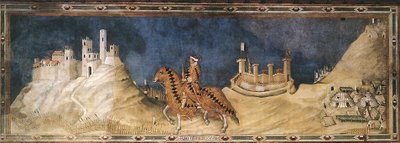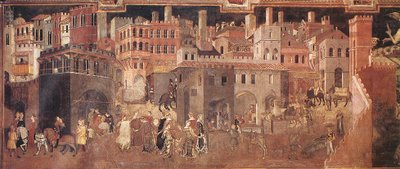 One cannot visit Italy without seeing some fantastic frescoes. Young Wenlock and I spent an hour or so queuing up outside the Vatican so that we could traipse through the museums before ending up in the Sistine Chapel, but given its reputation, the ceiling was always going to be a bit of a disappointment. I did quite like the Last Judgement, but Young Wenlock was more taken by Hannibal invading Italy on the wall of the Palazzo dei Conservatori.
One cannot visit Italy without seeing some fantastic frescoes. Young Wenlock and I spent an hour or so queuing up outside the Vatican so that we could traipse through the museums before ending up in the Sistine Chapel, but given its reputation, the ceiling was always going to be a bit of a disappointment. I did quite like the Last Judgement, but Young Wenlock was more taken by Hannibal invading Italy on the wall of the Palazzo dei Conservatori.Frescoes being found indoors, usually, and restrictions placed on taking photographs, the rest of this post will be illustrated by other people's pictures. What I have found, however, is that they rarely tend to capture the colourfulness of the real thing.
 Siena has some wonderful frescoes. Simone Martini's Maesta of 1315, in the Palazzo Publico, is a great deal brighter and bluer than this picture (or the larger version that it links to) would have you believe. You might get a better idea of the colours from the Siena website, but their picture is so very blurred.
Siena has some wonderful frescoes. Simone Martini's Maesta of 1315, in the Palazzo Publico, is a great deal brighter and bluer than this picture (or the larger version that it links to) would have you believe. You might get a better idea of the colours from the Siena website, but their picture is so very blurred.Opposite the Maesta is a slightly controversial fresco, the Equestrian Portrait of Guidoriccio da Fogliano. If it really is also by Martini, as has long been believed, it would be one of the earliest Italian portraits. It would also have anachronistic castles. There is therefore an increasingly strong case (supported by suggestions of previous works underneath this one, that it is not by Martini, and that it may be a 16th Century fake. But even if it is a later work it is still spectacular.

Martini is good, but the really star of Sienese frescoes was Ambrogio Lorenzetti, whose Allegory of Good and Bad Government (1338-1340) is also in the Palazzo Publico. This is a set of six pictures. Two are allegorical images of Siena under good and bad governments (the former is better preserved than the latter). Then there are pictures showing the effect on town and countryside of good and bad government. The former are, again, better preserved than the latter).

Next time I will say a bit about Florence, including the fantastic frescoes by Domenico Ghirlandaio in the Capella Tornabuoni of Santa Maria Novella.

1 comment:
Hi Stephen,
You won my contest! Email me to let me know which prize you want.
azureus
at
harborside
dot
com
Congratulations.
Post a Comment